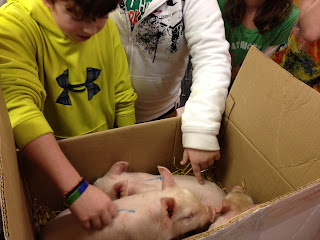It is hard to believe that the Peaches' piglets turned one-month-old on Thursday, March 21. And, to top off their big day, they had a VERY special visitor stop by! That's right, our District Superintendent, Dr. Harner, stopped by to wish them a BIG bundle of birthday wishes - it was the FIRST time he saw them and had the opportunity to pay them a visit. Needless to say, they squealed with joy!
Aside from a visit from our school district's top administrator, the piglets have a had a busy past few weeks. Three of them took their first field trip to Silver Spring Elementary on Friday, March 15 to visit the fifth grade students. All three piglets were sure to get their parent permission form signed by Peaches before they traveled up the hill with their chaperones, Mr. Woods and Mr. Toevs. Upon arriving, the students at Silver Spring were ecstatic to see the three little pigs that came to see them - but, there was no huffing, and puffing, or blowing down of houses!
'Early exposure to agriculture and realization of how the stewards of our land - the American Farmer - produce enough food to feed, clothe, and shelter our vastly growing population is essential the survival of mankind for decades to come.'
Nope, not at all - conversely, the piglets enjoyed the many small hands that scratched them behind their ears and rubbed their tummies. The three little pigs were so relaxed they even decided to take a nap! It was a great learning experience for both the piglets and students.
So, what else is new with Peaches and the Piglets?
*On Monday, March 18, everyone was relocated from the greenhouse and now live in the Ag Suite Bay Area. Why? Because it is time to fill the greenhouse with spring veggies and bedding plants.
*Can visitors still come see them? Yes! Of course! Just get in contact with Mr. Woods (mwoods@cvschools.org)
*What about the video feed? The feed has been discontinued for the time being, but we open our doors to you after school hours to come visit!
*Major events will be recorded and posted to YouTube and this blog.
*The piglets are still nursing from Peaches, BUT - they have started to eat solid feed and drink water too!
Update on Peary
Well, there is not much to say. Peary has made a full recover and is energetic as one would expect a one-month-old piglet to be! She is full of life, starting to gain weight, and competitively nurses from Peaches with her siblings. She is certainly a 'little pig' when it comes to claiming one of Peaches' teats.
What is the next step for the Piglets?
The piglets will make a big debut at Cumberland Valley Ag Sciences and FFA's spring agricultural awareness event on April 20. A-Day for Agriculture: Connecting Communities is a community event held at the High School to promote agricultural and environmental awareness. Anyone and everyone from across Pennsylvania is invited to attend our FREE event.
Check out: www.cvschools.org/ADay for more information!
Until next time...
'Like' us on Facebook to see more pictures and 'Follow' us on Twitter to see the great things happening with CV Ag Sciences and FFA!
*Note: Due to the lack of 'excitement' as the piglets nurse and grow, this blog will be updated weekly versus daily* More to come as their life progresses! Keep tuning in!






































